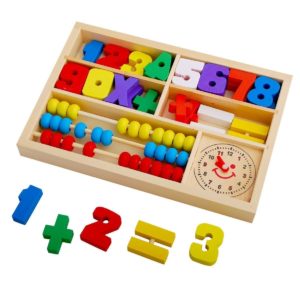
A man observes a bookshelf filled with various puzzles, nestable games, abacuses and wooden trains in a Juguettos store in Ávila. Right next to it are a pair of small robots that claim to be able to teach the letters and colors to the little ones and dance with them or “parade together in circles”. The difference between the first toys and the second ones is, precisely, technology: traditional games of all life in front of machines. Many parents have begun to fear the excessive use of tablets and smartphones by children and choose to give their children creative toys with few technological components.
This is the case of Marisol Napal, a mother who walks through Juguettos in search of gifts. She has 3 children; of 19, 6, and 1 years, respectively. “The medium kid plays a lot with the Playmobile and the little one is entertained even with some cutlery”, she says with a smile. He likes his children to use traditional toys because “they are more awake and they become more imaginative”, although from time to time they do allow them to watch some video on their mobile or on the computer. But one of their concerns is that they spend too much time in front of the screens: “My nephews are totally hooked”.
“There is a sector of the population, especially parents with children under 3 years of age, who are interested in traditional toys that do not have as much electronic component as counter-trends in front of the excessive use that is being made of technology”, explains María Costa, Director of Children’s Research at the Technological Institute for Children’s Products and Leisure (AIJU) and PhD in Pedagogy.
In fall, Amazon sent a catalog of its best-selling toys to thousands of its customers. In the colorful brochure, there were several technological products such as the Echo Dot Kids smart speaker or items from Bose, Xbox or the PlayStation. But there were also Harry Potter toys or the incredible and classic ones like Barbie, Monopoly, or different Lego sets. And there were even simple, colorful wooden toys such as an ice cream case, a small broom or a shopping cart. These last 3 products are manufactured by Melissa & Doug, an American company that sells toys that do not require batteries and lack any electronic component, according to the Vox news website.
Costa explains that simple dolls, seesaws, or wooden toys where the key is to combine pieces can help children “develop more emotional, affectional, creative, and manipulative skills”. “This type of product puts the child in the central place and emphasizes a much more experiential experience of the toy than in other cases where technology or mechanisms make children more spectators of the game than protagonists”, he says.

In addition, with traditional toys children “let the imagination fly” and improve fine and gross motor skills. This is what Luis Miguel Rodríguez, in charge of this store of Juguettos in Ávila, confirms that there has been an increase in sales of this type of games due to the parents’ rejection of so much technology: “There has been an increase in the demand for classic toys such as Nenuco type dolls, scooters, and abacuses, since there is an academy that teaches mathematics with them”.
In his shop, 75% of toys do not have the technology. “Out of the remaining 25%, 15% are tablets or video game consoles and the rest are interactive dolls,” he says while pointing to a toy baby in whose belly says “try me”. Despite the increase in interest in products without technology, practically half of the toys that children have received in the last year in Spain have mechanisms or technology, according to the Aiju guide 2018-2019.
The technological toys best valued by families are usually educational. It highlights, for example, robotics and programming kits, pets, and interactive dolls, video games, or even watches. In addition, there are traditional toys that have incorporated technology. “Now you can play table games in the traditional way or through an App on your mobile, tablet or television”, explain sources from the Spanish Association of Toy Manufacturers (AEFJ).
First contact with technology
There are parents who expose their children to screens since they are very young, as Costa says: “At 9 months we already found many children who are using the tablet or even the mobile phone to entertain themselves while their parents have dinner in a restaurant”. 35% of children between 0 and 12 years old access the internet every day, according to Aiju. In addition, 1 in 5 children between 0 and 3 years surf the web on a daily basis. While it is true that technological toys can help improve the digital skills of children, Aiju considers appropriate to regulate their consumption so that children can “perform other activities as important as the game abroad”.
The American Academy of Pediatrics defends that children from 0 to 2 years should not be exposed to screens, those from 2 to 5 years between an average or an hour a day and those from 7 to 12 years, an hour and a half maximum. “Technology does not have to be harmful. What is harmful is that they abuse it: the fact that they play many hours with technology, the bad thing is that they stop playing a more active and more manipulative and experiential game”, adds Costa.
Over the years, more sedentary, individual and indoor games have been increasing while active, collective and gambling games have declined abroad, according to the Aiju in their guide. When current parents remember their childhood, the most cited games are rubber, rope, and dolls. While the game activities most cited by children today are going to the park, playing with mobile or tablet, drawing, crafts, and construction games.
For example, Álvaro García, a 12-year-old boy who watches robots in Juguettos, plays Lego frequently. Although he prefers to use the Nintendo Switch or videos on his mobile, according to his father, Juan José García. “He plays 2 hours a day and sometimes we have to stop his feet,” he explains. Álvaro has clear advantages and disadvantages of playing video games: “The good thing is that they stimulate the mind and help you think. But they are bad for the eyes and, in addition, you can be vitiated”.
The addiction to video games is consolidated as a mental problem that affects 9 out of every 100 users. “New technologies have addressed all areas of people’s lives, including children”, explains Costa. Faced with them and the excessive use of screens and technology, Costa says that “traditional toys will always be sold without any technology”: “In the same way that we continue to interact with books and there are e-books, children will interact with toys with mechanisms and without them”, he concludes.

